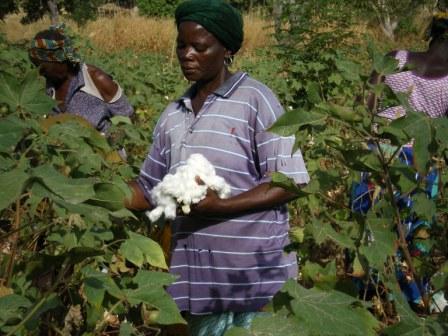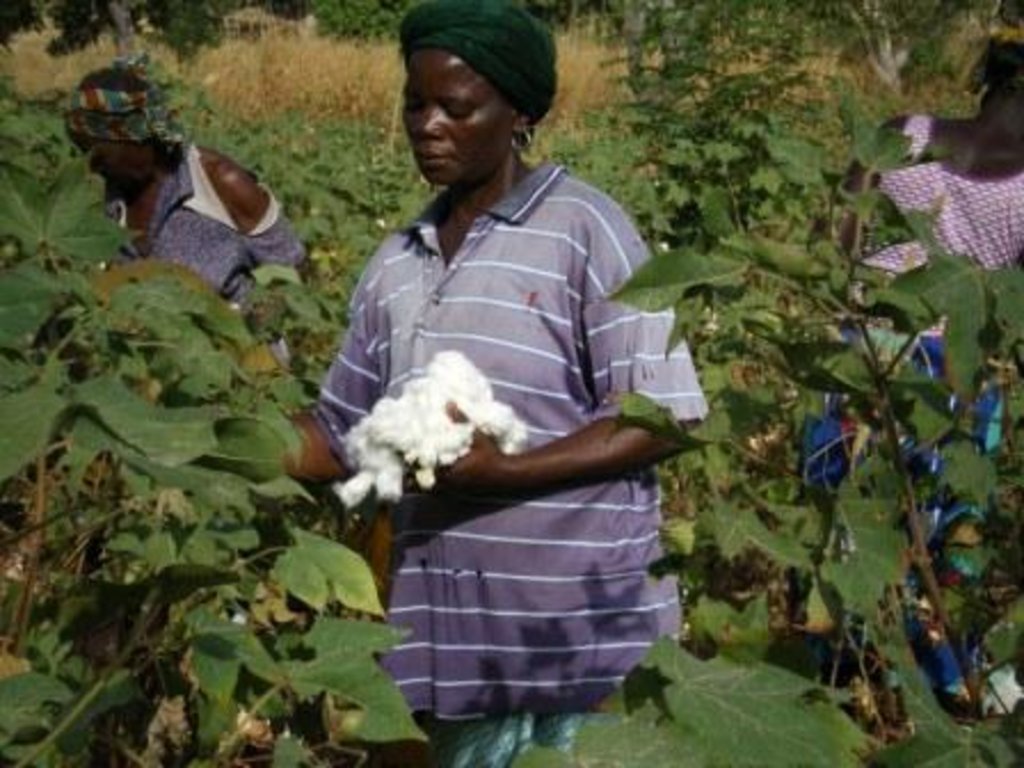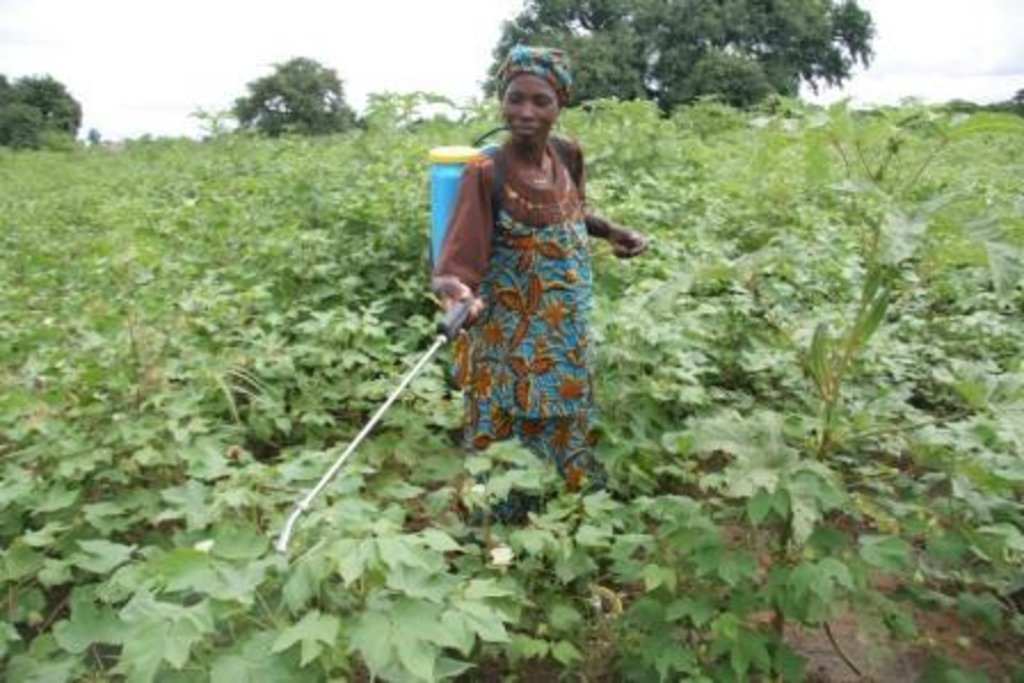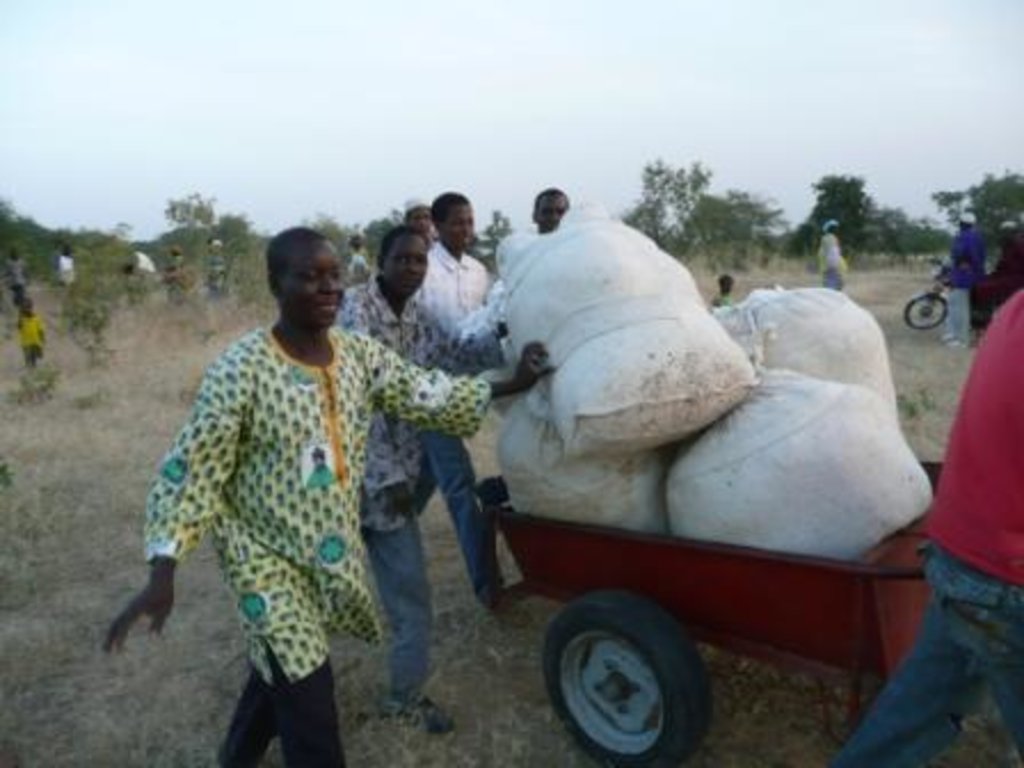Organic cotton [布基纳法索]
- 创建:
- 更新:
- 编制者: Julie Zähringer
- 编辑者: –
- 审查者: Alexandra Gavilano
technologies_957 - 布基纳法索
查看章节
全部展开 全部收起1. 一般信息
1.3 关于使用通过WOCAT记录的数据的条件
编制者和关键资源人员接受有关使用通过WOCAT记录数据的条件。:
是
2. SLM技术的说明
2.1 技术简介
技术定义:
In the Loba province of Burkina Faso, the production, storage, processing and marketing of organic cotton has been promoted since 2004 by Helvetas.
2.2 技术的详细说明
说明:
Organic cotton production adheres to the principles and standards of organic farming. Any application of synthetic fertilizers and pesticides and the use of genetically modified varieties are forbidden. Organic cotton relies on a combination of different measures: (1) the use of organic fertilizers (manure or compost) and recycling of organic matter; (2) Crop rotation and/or intercropping; (3) Careful selection of varieties adapted to local conditions (climate, soil, pests and diseases); (4) Biological pest management (in combination with careful monitoring of crops); (5) Clear separation of organic and conventional cropland, e.g. by growing border crops (to avoid contact with chemical substances through spray drift or surface runoff); and (6) Soil and water conservation measures. Timely crop management (e.g. weeding) is very important. In Loba rotations crops include sesame (a cash crop), cereals and legumes (food crops), while intercrops include leguminous green manure and trap plants. The best adapted cotton variety is FK-37. Bio-pesticides are produced based on neem seeds (Azadirachta indica). The measures listed above help to improve soil fertility, reduce production costs (and thus financial risk) and avoid the negative effects of conventional farming: declining yields, resistance to pests and diseases, health hazards and environmental problems caused through the use of chemicals. By relying on inputs available/produced on the farm and by getting a better price for certified organic products, profitability of the farm is improved in the long run despite of lower productivity compared to conventional or genetically modified (GM) cotton. Farms need to complete a 3-year conversion period to change their production system from conventional to organic. Farmers have to maintain records and documents for periodic inspection and certification (Internal control system).
2.3 技术照片
2.5 已应用该技术的、本评估所涵盖的国家/地区/地点
国家:
布基纳法索
区域/州/省:
Ioba province
有关地点的进一步说明:
Dano
2.6 实施日期
如果不知道确切的年份,请说明大概的日期:
- 不到10年前(最近)
2.7 技术介绍
详细说明该技术是如何引入的:
- 通过项目/外部干预
3. SLM技术的分类
3.2 应用该技术的当前土地利用类型

农田
- 多年一作(非木材)
注释:
Major land use problems (land users’ perception): Fertility decline and reduced OM content; Biodiversity decline
3.3 有关土地利用的更多信息
该技术所应用土地的供水:
- 雨养
3.5 技术传播
注释:
around 7'000 farmers
3.6 包含该技术的可持续土地管理措施

农艺措施
- A2:有机质/土壤肥力
注释:
Main measures: agronomic measures
Type of agronomic measures: mixed cropping / intercropping, legume inter-planting, manure / compost / residues
3.7 该技术强调的主要土地退化类型

化学性土壤退化
- Cn:肥力下降和有机质含量下降(非侵蚀所致)

生物性退化
- Bs:质量和物种组成/多样性的下降
注释:
Main type of degradation addressed: Cn: fertility decline and reduced organic matter content, Bs: quality and species composition /diversity decline
3.8 防止、减少或恢复土地退化
具体数量名该技术与土地退化有关的目标:
- 减少土地退化
- 防止土地退化
注释:
Main goals: prevention of land degradation, mitigation / reduction of land degradation
4. 技术规范、实施活动、投入和成本
4.2 技术规范/技术图纸说明
Technical knowledge required for field staff / advisors: high
Technical knowledge required for land users: moderate
Main technical functions: improvement of ground cover, increase in organic matter, increase in nutrient availability (supply, recycling,…), promotion of vegetation species and varieties (quality, eg palatable fodder)
Secondary technical functions: improvement of water quality, buffering / filtering water
Mixed cropping / intercropping
Material/ species: intercrops include leguminous green manure and trap plants
Manure / compost / residues
Material/ species: manure or compost
Agronomic measure: bio-pesticides
Material/ species: from Neem seeds (Azadirachta indica)
4.6 维护/经常性活动
| 活动 | 措施类型 | 时间/频率 | |
|---|---|---|---|
| 1. | Compost production / Clear crop residues on fields where cotton will be planted, use for mulch or compost production (no burning) | 农业学的 | |
| 2. | Apply organic manure: 7.5 t/ha / Ploughing (for incorporation of manure, pest and weed control) | 农业学的 | |
| 3. | Sow cotton and intercrops (such as Hibiscus esculentus – a trap plant for pests; or Mucuna – a green manure plant); Thin out cotton after 10-20 days (1-2 plants per pocket) | 农业学的 | |
| 4. | Weeding (3 to 4 times: 20/40/70/100days after sowing) / Pest control (manual collection); Spraying of bio-pesticide (64 liters / ha, based on neem seeds): according to infestation: up to 3 times | 农业学的 | |
| 5. | Ridging (form furrows and ridges using plough or manually) / Pre-harvest weeding / Harvesting / Cut cotton stems / residues and incorporate into the soil | 农业学的 |
4.7 维护/经常性活动所需要的费用和投入(每年)
注释:
Machinery/ tools: hoe, plough, wheel-barrow, knapsack
4.8 影响成本的最重要因素
描述影响成本的最决定性因素:
Standard equipment (hoe, plough, wheel-barrow) is not included in costs, knapsack is provided by producer’s association (UNPCB) on credit; transport bags are donated. Labour and other inputs for erosion control measures (e.g. stone bunds) are not included in costs. Neem biocide costs US$ 0.7 per liter; organic cotton seeds cost US$ 1.7 per 50 kg.
5. 自然和人文环境
5.1 气候
年降雨量
- < 250毫米
- 251-500毫米
- 501-750毫米
- 751-1,000毫米
- 1,001-1,500毫米
- 1,501-2,000毫米
- 2,001-3,000毫米
- 3,001-4,000毫米
- > 4,000毫米
农业气候带
- 半干旱
Thermal climate class: tropics. tropical, with high rainfall variability
5.2 地形
平均坡度:
- 水平(0-2%)
- 缓降(3-5%)
- 平缓(6-10%)
- 滚坡(11-15%)
- 崎岖(16-30%)
- 陡峭(31-60%)
- 非常陡峭(>60%)
地形:
- 高原/平原
- 山脊
- 山坡
- 山地斜坡
- 麓坡
- 谷底
垂直分布带:
- 0-100 m a.s.l.
- 101-500 m a.s.l.
- 501-1,000 m a.s.l.
- 1,001-1,500 m a.s.l.
- 1,501-2,000 m a.s.l.
- 2,001-2,500 m a.s.l.
- 2,501-3,000 m a.s.l.
- 3,001-4,000 m a.s.l.
- > 4,000 m a.s.l.
5.3 土壤
平均土层深度:
- 非常浅(0-20厘米)
- 浅(21-50厘米)
- 中等深度(51-80厘米)
- 深(81-120厘米)
- 非常深(> 120厘米)
土壤质地(表土):
- 细粒/重质(粘土)
- 粗粒/轻(砂质)
表土有机质:
- 中(1-3%)
5.6 应用该技术的土地使用者的特征
生产系统的市场定位:
- 混合(生计/商业
个人或集体:
- 个人/家庭
机械化水平:
- 手工作业
- 畜力牵引
说明土地使用者的其他有关特征:
Difference in the involvement of women and men: certain activities carried out in mutual help groups
Population density: 50-100 persons/km2
5.7 应用该技术的土地使用者拥有或租用的平均土地面积
- < 0.5 公顷
- 0.5-1 公顷
- 1-2 公顷
- 2-5公顷
- 5-15公顷
- 15-50公顷
- 50-100公顷
- 100-500公顷
- 500-1,000公顷
- 1,000-10,000公顷
- > 10,000公顷
这被认为是小规模、中规模还是大规模的(参照当地实际情况)?:
- 小规模的
5.8 土地所有权、土地使用权和水使用权
土地所有权:
- 州
土地使用权:
- 个人
注释:
group (family clans) / state
6. 影响和结论性说明
6.1 该技术的现场影响
社会经济效应
收入和成本
农业收入
社会文化影响
健康状况
生态影响
土壤
养分循环/补给
土壤有机物/地下C
生物多样性:植被、动物
有益物种
6.3 技术对渐变气候以及与气候相关的极端情况/灾害的暴露和敏感性(土地使用者认为的极端情况/灾害)
注释:
Tolerant to climatic extremes due to higher water retention capacity of soils, reduced erosion and crop diversification (reduced risk of total crop failure)
6.4 成本效益分析
技术收益与技术建立成本相比如何(从土地使用者的角度看)?
短期回报:
消极
长期回报:
稍微积极
技术收益与技术维护成本/经常性成本相比如何(从土地使用者的角度看)?
短期回报:
积极
长期回报:
非常积极
注释:
Establishment costs are higher than revenues due to investments & initial decrease in yield (conversion period). On the long term, advanced farmers can achieve same or even higher yields than conventional cotton systems
6.5 技术采用
注释:
100% of land user families have adopted the Technology with external material support
Comments on adoption trend: The proportion of organic cotton is growing
6.7 该技术的优点/长处/机会
| 编制者或其他关键资源人员认为的长处/优势/机会 |
|---|
| This technology helps to improve soil fertility, reduce production costs (and thus financial risk) and avoid the negative effects of conventional farming: declining yields, resistance to pests and diseases, health hazards and environmental problems caused through the use of chemicals |
6.8 技术的弱点/缺点/风险及其克服方法
| 土地使用者认为的弱点/缺点/风险 | 如何克服它们? |
|---|---|
| Lack of water | establish water retention structures |
| 编制者或其他关键资源人员认为的弱点/缺点/风险 | 如何克服它们? |
|---|---|
| Coexistence of organic and GMO cotton resulting in high risk of contamination | intensify training of farmers; set up a coordination platform between organic and GMO farms; GMO communication plan; establish a sampling & testing system |
| Insufficient application of manure / compost | training on compost production; promote supply of organic manure (e.g. through SMEs specialized in compost production). |
| Large distance to cotton fields (resulting in high transportation costs) due to interfering of browsing livestock close to village | hay-making and corralling of livestock. |
| Lack of land, land ownership and land security | promote land leasing; resolve tenure problem on political level. |
| Lack of equipment (e.g. plough) | Develop and maintain access to credits for small-scale farmers. |
7. 参考和链接
7.2 参考可用出版物
标题、作者、年份、ISBN:
Helvetas. 2008. Guide de production - Un manuel de reference (Authors: Ouedraogo A, Yombi L, Doumbia S, Eyhorn F, Dischl R)
标题、作者、年份、ISBN:
Eyhorn F., S.G. Ratter, M. Ramakrishnan. 2005. Organic Cotton Crop Guide – A Manual for Practitioners in the Tropics; Research Institute of Organic Agriculture FiBL, Frick, Switzerland
链接和模块
全部展开 全部收起链接
无链接
模块
无模块







